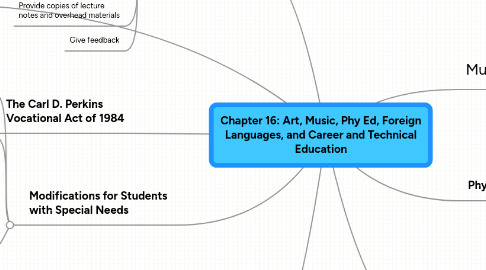
1. Foreign Languages
1.1. Methods are similar to those used in whole instruction.
1.2. Use mnemonic strategies.
1.3. Encourage the use of note cards
1.4. Provide specific memory strategies or have them come up with their own.
1.5. Share memory strategies with peers.
1.6. Technology such as audiocassettes, CD's, and software.
1.7. Record lectures
1.8. Provide copies of lecture notes and overhead materials
1.9. Give feedback
2. Instructional Strategies
2.1. Teach procedures for career and technical tasks
2.2. In crease time on task
2.3. Individualize Instruction
3. Career and technical Education
3.1. Seven Areas
3.1.1. Agriculture
3.1.2. Business
3.1.3. Family & consumer sciences
3.1.4. marketing
3.1.4.1. Modifications
3.1.4.1.1. Set Goals & Objectives
3.1.4.1.2. Modify environment
3.1.4.1.3. Modify Curriculum
3.1.5. health
3.1.6. trade & industry
3.1.7. technical communications
4. Modifications for Students with Special Needs
4.1. Help them set realistic goals
4.2. modify environment for students with physical disabilities
4.3. Make modifications to the curriculum
4.3.1. provide basic safety instructions
4.3.2. make modifications to text
4.3.2.1. rewrite text for students with reading difficulties making it simpler, and possibly highlight important points
4.3.2.2. put important parts of text in audio form such as on cd or voice thread
4.3.2.3. create a visual with sound such as a dvd or voice thread for specific topics
4.3.3. provide students with computer software that will help them in their learning
5. The Carl D. Perkins Vocational Act of 1984
5.1. Each state is obligated to provide educational programs to increase participation and meet the needs of underserved groups
6. Art Adaptations
6.1. stock adpated art materials
6.2. model fine and gross motor skills
6.2.1. New node
6.3. enforce guideline & rules for safety
6.4. assign roles ahead of time
6.5. allow ample practice time
6.6. break long assignmens into chunks
6.7. showcase works from all artists
7. Music Adaptations
7.1. monitor pace of songs
7.2. allow ample practice time
7.3. adapt instruments
7.4. modify response formats
7.5. use mnemonic devices for memorizing musical notes
8. Phy Ed Adaptations
8.1. use buddy system
8.2. avoid student selected teams
8.3. modify activites
8.3.1. to promote coordination
8.3.2. so students don't tire as fast
